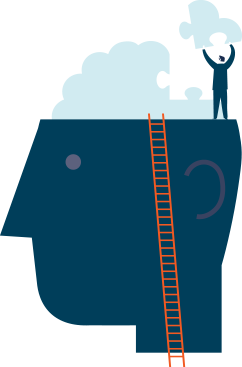For references to the studies discussed in this info sheet, see the reference list.

On this page: |
What is caffeine?
Caffeine is a psychoactive (mind-altering) drug that affects how we think and feel. It is a stimulant that speeds up our breathing, heart rate, thoughts and actions.
Caffeine is found in the seeds, leaves and fruit of certain shrubs, including coffee and tea plants. It can also be manufactured in a laboratory. A variety of everyday foods and beverages contain caffeine, including chocolate, cocoa, coffee, tea, soft drinks and energy drinks. It is also used in the making of some pain relievers, cold medicines and other medications.
Why do we use caffeine?
People use caffeine for various reasons. Many of us enjoy the taste of popular caffeinated products such as latte and chocolate. Students sometimes use caffeine tablets to power through long nights at the study table. Shift workers also use caffeine products to help adjust their minds and bodies to odd work hours. Some people use caffeinated energy drinks to improve their endurance while playing sports or to dance for long periods. Caffeine has many benefits but, like any drug, there is also risk of harms.
Most of us discover that, while using caffeine may help us stay alert, consuming the drug throughout the day or too close to bedtime may lead to problems. And, frequently buying specialty caffeinated beverages may lead to less money for other things we enjoy.
What happens when we use caffeine?
Caffeine is absorbed through the stomach into the bloodstream. Once in the bloodstream, it travels to the brain. Because caffeine is a stimulant, it increases activity in the brain and other parts of the central nervous system. Some people may be more sensitive to the effects of caffeine than others. Instead of feeling energetic, some of us may feel nervous or restless. The factors that can influence how caffeine will affect us include
-
how much and how often we have used caffeine,
-
our present mood and surroundings, and
-
our mental and physical health condition.
Impact on well-being
Caffeine can have both positive and negative effects on our well-being. For instance, research shows the addition of caffeine to commonly used analgesics such as ASA and acetaminophen improves the pain relief benefits of the medications. Moderate amounts of caffeine may help increase our focus and attention. However, consuming larger amounts may lead to agitation, irritability and sleep problems. And, while energy drinks may help boost stamina on the dance floor or when playing sports, the combination of fluid loss from sweating and the diuretic effects of more than moderate amounts of caffeine can leave us dehydrated.
Available evidence cannot answer whether or not regularly consuming more than moderate amounts of caffeine increases risk of heart disease. And, though early research suggested a link between caffeine and calcium loss and osteoporosis, more recent studies suggest the risk is low for people who consume moderate amounts of caffeine with recommended daily amounts of calcium. A woman who consumes more than 300 mg of caffeine per day when pregnant may give birth to a baby with a lower body weight.
When is using caffeine a problem?
Using caffeine is a problem when it negatively affects our life or the lives of others. We may think this refers to people who regularly use large amounts of caffeine, but even using on a single occasion can sometimes lead to a problem. For instance, using energy drinks while dancing for a long time in a hot club may leave us dehydrated. What’s important to recognize is the potential for adverse consequences as well as benefits related to the context of use and over time.
Caffeine use, especially regular use, by young people has particular risks. Like other psychoactive drugs, caffeine can interfere with normal brain development.
While most people who use caffeine do not become dependent on the drug, those who use caffeine regularly may feel they need to use caffeine to feel normal and function during the day. People who stop using caffeine after regular use may experience mild feelings of withdrawal, including irritability, headache, decreased alertness, difficulty concentrating and fatigue. These symptoms usually begin 12 to 24 hours after last consuming caffeine, and will gradually fade within a few days.
Mixing caffeine with other substances
People sometimes mix caffeine with other substances to experience different feelings or to offset the effects. For instance, a person may use a sleeping pill to help them relax and rest after using caffeine. But combining substances is risky as they can act in unexpected ways. The following are some common combinations and possible results.
Alcohol and other depressants
Since caffeine is a stimulant and alcohol is a depressant, combining caffeine and alcohol can cloud our judgment about how intoxicated we are and lead to risky behaviours such as impaired driving.
Stimulants
Combining caffeine with other stimulant drugs such as methamphetamine can intensify the effects on our breathing and heart rate.
Medications
When prescription or over-the-counter medications are used with caffeine, there is the potential for side effects or for the medicinal benefits to cancel out. Taking the time to read medication labels or consulting with a healthcare professional can reduce these risks.
How to make healthier choices about caffeine
Low-risk use
Reduce your risk by limiting daily intake to:
- 400 mg for adults
- 300 mg for pregnant women and breast-feeding mothers
- 45 mg for children aged 4-6
- 63 mg for children aged 7-9
- 85 mg for children aged 10-12
Whenever we choose to use caffeine, it is helpful to know what steps we can take to ensure that our use is the least harmful possible. The following are some useful guidelines to follow.
Not too much. Managing the amount we use in a given period can help to decrease negative effects.
Tip: When consuming caffeinated beverages, drink slowly and alternate with water. Avoid use close to normal bedtime.
Not too often. Limiting how often we use helps reduce risk of harms over time.
Tip: Reflect on your pattern of use and identify situations where you are likely to consume caffeine. And then consider changes to those patterns. For example, you might replace the “bottomless” cup of coffee with periods of exercise to stimulate yourself and adopt a ritual of treating yourself to one espresso at a particular time of the day.
Only in safe contexts. Making informed choices about where we use caffeine helps to minimize harms.
Tip: Avoid using caffeinated energy drinks when dancing in a hot, crowded environment.
Caffeine counts
|
|
Serving size |
Milligrams of caffeine (approximate amounts) |
|
Coffee |
1 cup or 8 oz | 120–180 mg |
|
Decaffeinated coffee |
1 cup or 8 oz | 3 mg |
|
Tea |
1 cup or 8 oz | 30-50 mg |
|
Cola |
12 oz or 355 ml | 35-50 mg |
|
Dark chocolate |
1 oz or 28 g | 20 mg |
|
Milk chocolate |
1 oz or 28 g | 7 mg |
What to do if you or someone you know wants to explore change
To better understand how substances play a role in your life, visit the You and Substance Use Workbook. This website also features detailed information on substance use and mental health.
You can also find information about a wide variety of substance use issues on the Centre for Addictions Research of BC website: www.carbc.ca.
For information on treatment options and resources throughout BC, call the Alcohol and Drug Information and Referral Service at 1-800-663-1441. In Greater Vancouver, call 604-660-9382.
About the author

The Canadian Institute for Substance Use Research, formerly CARBC, is a member of the BC Partners for Mental Health and Substance Use Information. The institute is dedicated to the study of substance use in support of community-wide efforts aimed at providing all people with access to healthier lives, whether using substances or not. For more, visit www.cisur.ca.
